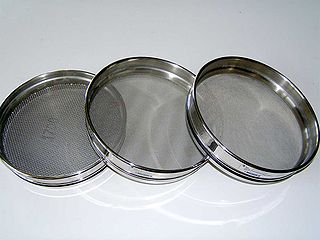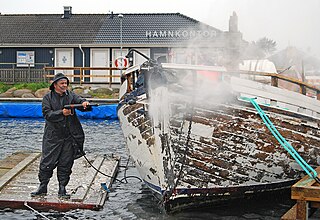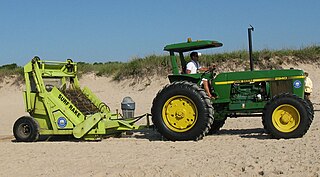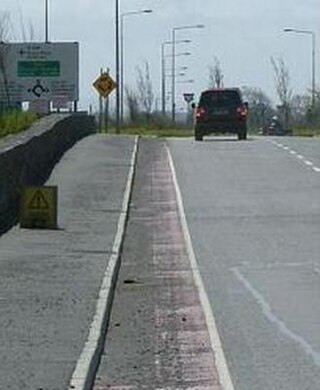
A vacuum cleaner, also known simply as a vacuum, is a device that uses suction, and often agitation, in order to remove dirt and other debris from carpets and hard floors.

A sieve, fine mesh strainer, or sift, is a tool used for separating wanted elements from unwanted material or for controlling the particle size distribution of a sample, using a screen such as a woven mesh or net or perforated sheet material. The word sift derives from sieve.
A drain cleaner, also known as drainopener, refers to a person, device, or product used to unblock sewer pipes or clear clogged wastewater drains. This term typically applies to chemical, enzymatic, or mechanical tools such as commercial chemical cleaners, plumber’s snakes, drain augers, bio-enzyme solutions, or toilet plungers. In some contexts, it may also refer to a plumber or professional who specializes in drain cleaning and maintenance.

A litter box, also known as a sandbox, cat box, litter tray, cat pan, potty, pot or litter pan, is an indoor feces and urine collection box for cats, as well as rabbits, ferrets, miniature pigs, small dogs, and other pets that instinctively or through training will make use of such a repository. They are provided for pets that are permitted free roam of a home but who cannot or do not always go outside to excrete their metabolic waste.

A street sweeper or street cleaner is a person or machine that cleans streets.

Litter consists of waste products that have been discarded incorrectly, without consent, at an unsuitable location. The word litter can also be used as a verb: to litter means to drop and leave objects, often man-made, such as aluminum cans, paper cups, food wrappers, cardboard boxes or plastic bottles on the ground, and leave them there indefinitely or for other people to dispose of as opposed to disposing of them correctly.

Marine debris, also known as marine litter, is human-created solid material that has deliberately or accidentally been released in seas or the ocean. Floating oceanic debris tends to accumulate at the center of gyres and on coastlines, frequently washing aground, when it is known as beach litter or tidewrack. Deliberate disposal of wastes at sea is called ocean dumping. Naturally occurring debris, such as driftwood and drift seeds, are also present. With the increasing use of plastic, human influence has become an issue as many types of (petrochemical) plastics do not biodegrade quickly, as would natural or organic materials. The largest single type of plastic pollution (~10%) and majority of large plastic in the oceans is discarded and lost nets from the fishing industry. Waterborne plastic poses a serious threat to fish, seabirds, marine reptiles, and marine mammals, as well as to boats and coasts.

Pressure washing or power washing is the use of high-pressure water spray to remove loose paint, mold, grime, dust, mud, and dirt from surfaces and objects such as buildings, vehicles and concrete surfaces. The volume of a mechanical pressure washer is expressed in gallons or liters per minute, often designed into the pump and not variable. The pressure, expressed in pounds per square inch, pascals, or bar, is designed into the pump but can be varied by adjusting the unloader valve or using specialized nozzle tips. Machines that produce pressures from 750 to 30,000 psi or more are available.

Carpet cleaning is performed to remove stains, dirt, debris, and allergens from carpets. Common methods include hot water extraction, dry-cleaning, and vacuuming.

An automated pool cleaner is a vacuum cleaner that is designed to collect debris and sediment from swimming pools with minimal human intervention.

A cleaner, cleanser or cleaning operative is a type of industrial or domestic worker who is tasked with cleaning a space. A janitor, also known as a custodian, porter or caretaker, is a person who cleans and might also carry out maintenance and security duties. A similar position, but usually with more managerial duties and not including cleaning, is occupied by building superintendents in the United States and Canada and by site managers in schools in the United Kingdom.

Swimming pool sanitation is the process of ensuring healthy conditions in swimming pools. Proper sanitation is needed to maintain the visual clarity of water and to prevent the transmission of infectious waterborne diseases.

H. Barber & Sons is a privately owned Naugatuck, Connecticut-based company that has sold more beach cleaning equipment than any other company in the world.

Road debris, a form of road hazard, is debris on or off a road. Road debris includes substances, materials, and objects that are foreign to the normal roadway environment. Debris may be produced by vehicular or non-vehicular sources, but in all cases it is considered litter, a form of solid waste. Debris may tend to collect in areas where vehicles do not drive, such as on the edges (shoulder), around traffic islands, and junctions.
Maize miller is the processing of maize (corn) for safe and palatable consumption as food. Processing can be by machine-milling in either large- or small-scale mills, or by hand-milling in domestic or community settings.

A bar screen is a mechanical filter used to remove large objects, such as rags and plastics, from wastewater. It is part of the primary filtration flow and typically is the first, or preliminary, level of filtration, being installed at the influent to a wastewater treatment plant. They typically consist of a series of vertical steel bars spaced between 1 and 3 inches apart.
Tumbler screening is a separation method that uses three-dimensional elliptical movement to separate very fine particles from larger ones.
Gyratory equipment, used in mechanical screening and sieving is based on a circular motion of the machine. Unlike other methods, gyratory screen operates in a gentler manner and is more suited to handle fragile things, enabling it to produce finer products. This method is applicable for both wet and dry screening.
High-frequency vibrating screens are the most important screening machines primarily utilised in the mineral processing industry. They are used to separate feeds containing solid and crushed ores down to less than 200 μm in size, and are applicable to both perfectly wetted and dried feed. The frequency of the screen is mainly controlled by an electromagnetic vibrator which is mounted above and directly connected to the screening surface. Its high-frequency characteristics differentiate it from a normal vibrating screen. High-frequency vibrating screens usually operate at an inclined angle, traditionally varying between 0° and 25° and can go up to a maximum of 45°. They should operate with a low stroke and have a frequency ranging from 1500 to 9000 RPM. Frequency in High frequency screen can be fixed or variable. Variable High Frequency screen is more versatile to tackle varied material condition like particle size distribution, moisture and have higher efficiency due to incremental increase in frequency. G force plays important role in determining specific screening capacity of screen in terms of TPH per sqm. G force increases exponentially with frequency.

Beach cleaning or clean-up is the process of removing solid litter, dense chemicals, and organic debris deposited on a beach or coastline by the tide, local visitors, or tourists. Humans pollute beaches with materials such as plastic bottles and bags, plastic straws, fishing gear, cigarette filters, six-pack rings, surgical masks and many other items that often lead to environmental degradation. Every year hundreds of thousands of volunteers comb beaches and coastlines around the world to clean this debris. These materials are also called "marine debris" or "marine pollution" and their quantity has been increasing due to anthropocentric activities.




















